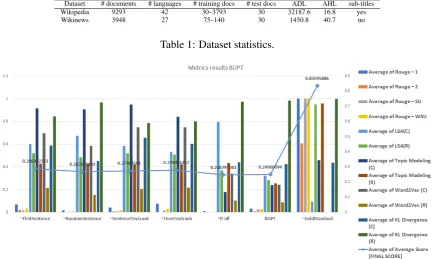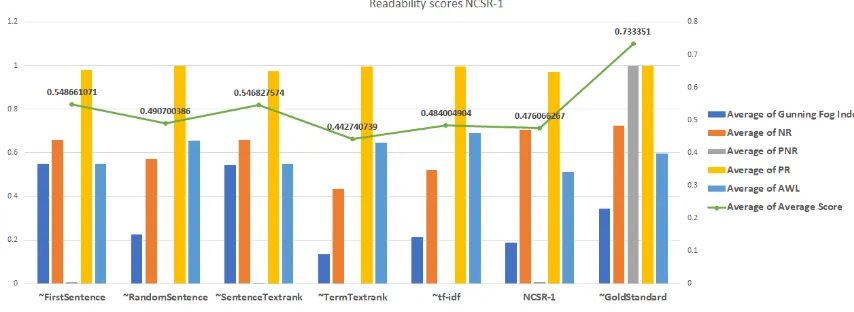Proceedings of the Multiling 2019 Workshop, co-located with the RANLP 2019 conference, pages 1–5 Varna, Bulgaria, September 6, 2019.
1
RANLP 2019 Multilingual Headline Generation Task Overview
Marina Litvak1, John M. Conroy2, and Peter A.Rankel3
1Shamoon College of Engineering, Beer Sheva, Israel
marinal@ac.sce.ac.il
2IDA/Center for Computing Sciences, 17100 Science Dr., Bowie, MD, USA
conroy@super.org
3Stratus Solutions Inc.
rankel@math.umd.edu
Abstract
The objective of the 2019 RANLP Mul-tilingual Headline Generation (HG) Task is to explore some of the challenges high-lighted by current state of the art ap-proaches on creating informative head-lines to news articles: non-descriptive headlines, out-of-domain training data, generating headlines from long documents which are not well represented by the head heuristic, and dealing with multilingual domain. This tasks makes available a large set of training data for headline genera-tion and provides an evaluagenera-tion methods for the task. Our data sets are drawn from Wikinews as well as Wikipedia. Partici-pants were required to generate headlines for at least 3 languages, which were eval-uated via automatic methods. A key as-pect of the task is multilinguality. The task measures the performance of multi-lingual headline generation systems using the Wikipedia and Wikinews articles in multiple languages. The objective is to as-sess the performance of automatic head-line generation techniques on text docu-ments covering a diverse range of lan-guages and topics outside the news do-main.
1 Introduction
Headline Generation (HG) is an active area of re-search. A headline of a document can be defined as a short sentence that gives a reader a general idea about the main contents of the story it en-titles. There have been many reported practical applications for headline generation (Colmenares et al.,2015;Buyukkokten et al.,2001;Linke-Ellis,
1999;De Kok,2008;Gatti et al.,2016) or related
tasks.
Automatic evaluation of automatically gener-ated headlines is a highly important task, in its own right, where a candidate headline is assessed with respect to (1) readability (i.e. whether the head-line is easy to understand), and (2) relevance (i.e. whether the headline reflects the main topic of an article).
The objective of the HG task is to stimulate re-search and assess the performance of automatic headline generation systems on documents cover-ing a large range of sizes, languages, and topics. This report describes the task, how the datasets were created, the methods used to evaluate the submitted headlines, and the overall performance of each system.
2 Task and Datasets Description
The specific objective of each participant system of the task was to generate a headline/title for each document in one of two provided datasets, in at least three languages. No restrictions were placed on the languages that could be chosen. To re-move any potential bias in the evaluation of gen-erated headlines that are too small, the gold stan-dard headline length in characters was provided for each test document and generated headlines were expected to be close to it. Two datasets were provided. Both are publicly available and can be downloaded from the MultiLing site.1
Wikipedia dataset
The dataset was created from the featured articles of Wikipedia, which are consists of over 13000 articles in over 40 languages. These articles are reviewed and voted upon by the community of Wikipedia editors who concur that they are the
best and that the articles fulfill the Wikipedia’s requirements in accuracy, neutrality, complete-ness, and style. As all featured article must have a summary, a subsets of these data were used at MulitLing 2013, 2015, and 2017 (Conroy et al., 2019). All the featured articles have titles for entire article and per section (sub-headings), thus, they also make an excellent corpus for re-search in headline generation. The Perl module Text::Corpus::Summaries::Wikipedia2is available
and can be used to create an updated corpus. The testing dataset for this task was created from a sub-set of this corpus by requiring that each language has 30 articles and that the size of each article’s body text be sufficiently large. A language was not select if the total number of remaining articles was less than 30.
Wikinews dataset
This dataset was created from the Wikinews ar-ticles. Since all featured articles have human-generated headlines, they make an excellent cor-pus for research in headline generation. The arti-cles in this dataset do not have sub-headings, and only the main headline per article needed to be generated by participants in the provided test data. We manually assessed the collected data and fil-tered out files with small body or short and non informative headlines. The script for data collec-tion is publicly available upon request. Table 1
shows the statistics about both datasets, includ-ing total number of documents, number of train-ing and test documents per language, average doc-ument and headline length in characters (denoted by ADL and AHL, respectively).
3 Evaluation
3.1 Metrics
Both submissions were evaluated automatically, with help of the HEvAS system (Litvak et al.,
2019). All headlines were evaluated in terms of multiple metrics, both from informativeness and readability perspectives. The informativeness metrics estimated the headlines quality at the lexi-cal and semantic levels, by comparison to the con-tent of gold standard headlines and the documents themselves.
The lexical-level informativeness metrics em-ployed are ROUGE (Lin,2004;Colmenares et al.,
2https://goo.gl/ySgOS
2015) (ROUGE-1,2,SU,WSU) and averaged KL-Divergence (Huang, 2008). At the semantic level, we measured content overlap above abstract “topics” discovered by Latent Semantic Indexing (LSI) (Colmenares et al., 2015), Topic Modeling (TM) (Blei et al.,2003;Blei,2012), and Word Em-bedding (WE) (Mikolov et al.,2013). The content overlap is calculated via comparison to the gold standard headlines (denoted by “similarity”) and the document itself (denoted by “coverage”).
The following readability metrics were com-puted: proper noun ratio (PNR) (Smith et al.,
2012), noun ratio (NR) (Hancke et al.,2012), pro-noun ratio (PR)(ˇStajner et al.,2012), Gunning fog index (Gunning, 1952), and average word length (AWL) (Rello et al.,2013).
The details about implementation of all these metrics can be found in (Litvak et al.,2019).
3.2 Baselines
For comparative evaluations and a possibility to get impression about relative performance of the evaluated systems, their scores were compared to five baselines that are implemented in HEvAS: (1) First compiles a headline from nine first words; (2)Randomextracts nine first words from a random sentence; (3)TF-IDF selects nine top-rated words ranked by theirtf −idf scores; (4)
WTextRankgenerates a headline from nine words extracted by the TextRank algorithm (Mihalcea and Tarau,2004) for the keyword extraction; and (5)STextRank extracts nine first words from the top-ranked sentence by the TextRank approach for extractive summarization.
3.3 Participants
Two teams submitted the results for the HG task. The teams are denoted by BUPT (Beijing Univer-sity of Posts and Telecommunications) and NCSR (National Centre for Scientific Research ”Dem-ocritos”). Table2contains the details about each team.
3.4 Results
Dataset # documents # languages # training docs # test docs ADL AHL sub-titles
Wikipedia 9293 42 30–3793 30 32187.6 16.8 yes
[image:3.595.81.516.63.322.2]Wikinews 3948 27 75–140 30 1450.8 40.7 no
[image:3.595.77.517.392.572.2]Table 1: Dataset statistics.
Figure 1: BUPT comparative results. Informativeness metrics.
Figure 2: NCSR comparative results. Informativeness metrics.
Team dataset # languages method BUPT Wikipedia 41 extractive NCSR Wikinews 3 abstractive
Table 2: Teams statistics.
in informativeness metrics. Because BUPT ex-tracted entire sentences, their headlines are less informative but most readable. The NCSR lines, conversely, are more informative than head-lines produced by some basehead-lines but not readable.
4 Conclusions
Figure 3: BUPT comparative results. Readability metrics.
Figure 4: NCSR comparative results. Readability metrics.
task. Their systems were able to improve over some of the baselines. Further analysis of the sub-mitted headlines, both system and baselines can be done to aid in development of stronger methods for automatic multilingual headline generation.
References
D M Blei. 2012. Probabilistic topic models.
Commu-nications of the ACM55(4):77–84.
D. M. Blei, A. Y. Ng, and M. I. Jordan. 2003. Latent
dirichlet allocation. Journal of Machine Learning
Research3:993–1022.
Orkut Buyukkokten, Hector Garcia-Molina, and An-dreas Paepcke. 2001. Seeing the whole in parts: text summarization for web browsing on handheld de-vices. InProceedings of the 10th international con-ference on World Wide Web. ACM.
Carlos A Colmenares, Marina Litvak, Amin Mantrach, and Fabrizio Silvestri. 2015. Heads: Headline gen-eration as sequence prediction using an abstract
feature-rich space. InProceedings of the 2015 Con-ference of the NAACL: HLT. pages 133–142.
John M. Conroy, Jeff Kubina, Peter A. Rankel, and
Julia S. Yang. 2019. Multilingual Summarization
and Evaluation Using Wikipedia Featured Articles, chapter Chapter 9, pages 281–336.
D De Kok. 2008. Headline generation for dutch news-paper articles through transformation-based learn-ing.Master’s thesis.
Lorenzo Gatti, Gozde Ozbal, Marco Guerini, Oliviero Stock, and Carlo Strapparava. 2016. Heady-lines: A
creative generator of newspaper headlines. In
Com-panion Publication of the 21st International Confer-ence on Intelligent User Interfaces. ACM, pages 79– 83.
Robert Gunning. 1952. The technique of clear writing. .
[image:4.595.79.506.276.432.2]Anna Huang. 2008. Similarity measures for text docu-ment clustering. Insixth New Zealand computer sci-ence research student confersci-ence (NZCSRSC2008). pages 49–56.
Chin-Yew Lin. 2004. Rouge: A package for automatic evaluation of summaries. InProceedings of the Text Summarization Branches Out workshop.
N. Linke-Ellis. 1999. Closed captioning in america:
Looking beyond compliance. InProceedings of the
TAO Workshop on TV Closed Captions for the Hear-ing Impaired People, Tokyo, Japan. pages 43–59.
Marina Litvak, Natalia Vanetik, and Itzhak
Eretz Kdosha. 2019. Hevas: Headline
evalua-tion and analysis system. In Recent Advances in
Natural Language Processing (RANLP).
Rada Mihalcea and Paul Tarau. 2004. Textrank: Bring-ing order into text. InProceedings of the EMNLP.
Tomas Mikolov, Kai Chen, Greg Corrado, and
Jef-frey Dean. 2013. Efficient estimation of word
representations in vector space. arXiv preprint
arXiv:1301.3781.
Luz Rello, Ricardo Baeza-Yates, Laura Dempere-Marco, and Horacio Saggion. 2013. Frequent words improve readability and short words improve under-standability for people with dyslexia. InIFIP Con-ference on Human-Computer Interaction. Springer, pages 203–219.
Christian Smith, Henrik Danielsson, and Arne J¨onsson. 2012. A good space: Lexical predictors in vector
space evaluation. In LREC 2012. Citeseer, pages
2530–2535.

